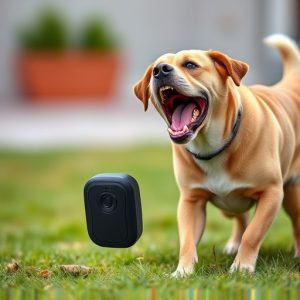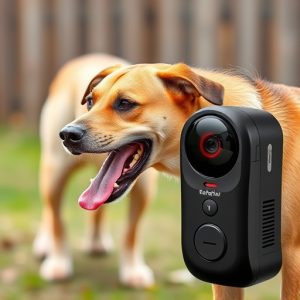Safe Dog Training with Ultrasonic Technology: Handheld Deterrents’ Effectiveness
Handheld sonic dog deterrents, emitting inaudible high-frequency sound waves, effectively modify can…….
Handheld sonic dog deterrents, emitting inaudible high-frequency sound waves, effectively modify canine behavior without violence. These devices respond instantly to unwanted actions like barking or jumping, creating an unpleasant sensation that conditions dogs to avoid such behaviors over time. For optimal results, integrate them into a broader training regimen combining positive reinforcement and consistent monitoring of the dog's behavior before, during, and after sessions. Responsible usage, tailored to each dog's temperament, involves consulting professionals, starting with lower settings, and varying device placement and timing.
Discover the revolutionary power of ultrasonic technology in dog training with our comprehensive guide. Learn how handheld sonic deterrents, emitting high-frequency sounds, offer a safe and effective approach to modifying canine behavior. Explore the science behind these devices, their proven effectiveness, and best practices for implementation. Understand why this modern method is gaining traction among trainers, and unlock the secrets to successful, positive dog training with ultrasonic technology.
- Understanding Ultrasonic Technology for Dog Training
- The Science Behind Handheld Sonic Deterrents
- Evaluating the Effectiveness of Sonic Dog Training Devices
- Best Practices and Considerations for Safe Implementation
Understanding Ultrasonic Technology for Dog Training
Ultrasonic technology has emerged as a innovative approach in dog training, offering a non-violent and effective method to modify behavior. This technology utilises high-frequency sound waves that are inaudible to humans but can be detected by dogs. The handheld sonic dog deterrents emit these ultrasonic signals when triggered by specific behaviors, such as barking or jumping on furniture. The sound is designed to be unpleasant for the dog without causing any physical harm, acting as a powerful deterrent and reinforcement tool.
The effectiveness of this method lies in its ability to capture the dog’s attention and quickly communicate a negative consequence. When a dog engages in unwanted behavior, the ultrasonic device responds instantly, creating an association between that action and an unpleasant sensation. Over time, this conditioning can help modify the dog’s behavior, teaching them to avoid certain actions. Moreover, as these devices are portable and easy to use, they offer a convenient solution for training both at home and during walks.
The Science Behind Handheld Sonic Deterrents
The science behind handheld sonic deterrents for dogs revolves around using ultrasonic sound waves to train and correct unwanted behaviors. These devices emit high-frequency sounds that are inaudible to humans but can be heard by canines. The effectiveness of handheld sonic dog deterrents lies in their ability to trigger an immediate response from dogs without causing any physical harm. When a dog exhibits undesirable behavior, the deterrent emits a specific sound frequency that disrupts its attention and discourages the action.
Over time, consistent use of these devices can train dogs to associate certain sounds with ceasing specific behaviors. The ultrasonic waves work by targeting the dog’s auditory system, which then communicates the correction message to their brain. This method is particularly useful for addressing issues like barking excessively, jumping on people, or pulling on leashes, as it offers a positive and humane way to teach dogs better alternatives without resorting to traditional punishment methods.
Evaluating the Effectiveness of Sonic Dog Training Devices
The effectiveness of handheld sonic dog deterrents has been a topic of interest for many pet owners and professionals alike. These devices emit high-frequency sound waves that are designed to disrupt a dog’s behavior without causing harm. While some studies suggest that they can be successful in modifying certain behaviors, such as barking or aggression, the overall effectiveness depends on various factors. The key to success lies in understanding the specific needs of your dog and using these tools appropriately.
Training devices should be used as part of a comprehensive approach, combining positive reinforcement and other training methods. Not all dogs respond in the same way, and what works for one may not work for another. Additionally, consistent use and patience are crucial. Evaluating the handheld sonic deterrent’s effectiveness requires close observation of your dog’s behavior before, during, and after training sessions, tailoring adjustments as needed to ensure positive results.
Best Practices and Considerations for Safe Implementation
When implementing handheld sonic dog deterrents, it’s crucial to adhere to best practices for safe and effective use. These devices emit ultrasonic sounds that are inaudible to humans but can be irritating to dogs, making them a powerful tool for training and deterring unwanted behaviors like barking or aggression. However, responsible usage is key to avoiding potential harm. Always consult with a professional trainer or veterinarian before introducing this technology to ensure it’s suitable for your dog’s age, breed, and overall health. Additionally, these devices should be used sparingly and as a last resort, as constant or prolonged exposure to the ultrasonic frequency might cause discomfort or even physical harm.
Placement is critical; use them in specific areas where problematic behaviors occur rather than spreading the noise throughout your home. Start with lower settings to gauge your dog’s reaction, gradually increasing only if necessary. It’s also essential to vary the device’s location and usage timing to prevent dogs from becoming accustomed to or desensitized to the sound. Regular training sessions with positive reinforcement techniques alongside sonic deterrents can lead to more significant and lasting behavior changes. Remember that each dog is unique, so tailoring your approach based on their temperament and progress will yield the best results.
Ultrasonic technology offers a safe and effective approach to dog training, with handheld sonic deterrents proving their worth in modifying canine behavior. By understanding the science behind this method and adopting best practices, trainers can ensure positive results while maintaining a harmonious relationship with their pets. The effectiveness of sonic dog training devices is supported by various studies, making it a reliable tool for addressing unwanted behaviors in a non-invasive manner.


